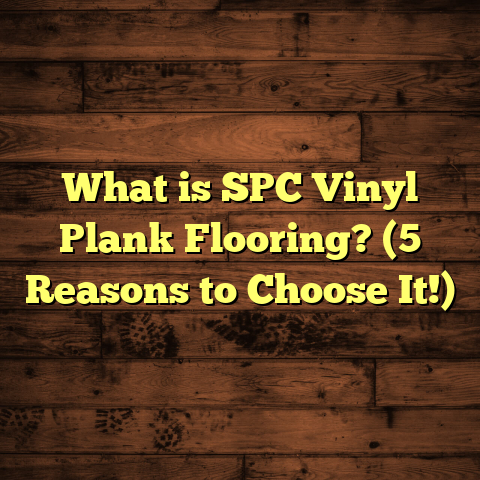What is the Cost for 496 Sq Ft of Vinyl Flooring? (5 Key Factors)
Bold Designs and Flooring Choices
There’s something about bold designs
that grabs attention and changes the whole
vibe of a space. When I talk about flooring,
I’m reminded of how much the right floor can
make or break a room’s style. Vinyl flooring is
one of those materials that lets you play with
design in fearless ways. But if you’re thinking
of covering 496 square feet with vinyl, you’re
probably wondering: what’s this going to cost me?
Let’s chat about the real deal behind the cost
of vinyl flooring for a space that size, plus the
five key factors that shape that price.
What Is the Cost for 496 Sq Ft of Vinyl Flooring?
When I say “cost for 496 sq ft of vinyl flooring,”
I mean the total expense involved in buying,
delivering, and installing vinyl flooring over
that exact area. This includes the material price,
labor charges, preparation work, and any additional
components like underlayment or trims.
Vinyl flooring itself comes in many forms — sheets,
planks, tiles — each with its own price point and installation
style. The “496 sq ft” figure helps frame everything
because flooring prices are almost always calculated per square foot.
In my experience, breaking down the total cost helps
avoid surprises. For instance, one project I worked on —
a mid-sized kitchen and dining area — had a similar square footage.
The initial quote seemed reasonable, but after factoring in subfloor
repairs and waste, the final bill was quite different.
This is why understanding each component of the cost is essential for any homeowner or contractor planning a vinyl flooring installation.
5 Key Factors That Affect Vinyl Flooring Cost
Let me walk you through five things that directly influence
how much you’ll pay when installing vinyl over 496 square feet.
1. Type and Quality of Vinyl Flooring
Not all vinyl flooring is created equal. You’ve got:
- Luxury Vinyl Planks (LVP): These mimic hardwood really well.
Prices range from about $3 to $7 per sq ft for material alone. - Luxury Vinyl Tiles (LVT): These look like stone or ceramic tiles.
They’re similarly priced but sometimes a bit more expensive due to design. - Sheet Vinyl: Rolls out in wider sections, usually cheaper —
roughly $1.50 to $4 per sq ft.
The difference between these types isn’t just about appearance; it’s also about durability, thickness, and installation complexity. For example, LVP typically has a thicker wear layer which makes it ideal for high-traffic areas. Sheet vinyl is thinner and tends to be better for smaller budgets or temporary installations.
In one of my projects, choosing LVP added a more modern feel but cost about 30% more than sheet vinyl. The finish and thickness also matter—thicker planks tend to be more durable and pricier.
How Thickness Impacts Price and Longevity
Vinyl flooring thickness varies from about 2mm up to 8mm or more in luxury options. Thicker floors usually have:
- Better sound insulation
- Increased comfort underfoot
- Longer lifespan due to wear layer
That extra durability can save money in the long run by delaying replacement. For the 496 sq ft we’re talking about, upgrading thickness by just 1mm might add $0.50 per sq ft but could double the lifespan of your floor.
2. Installation Complexity and Labor Costs
Labor can really change your budget. Basic installation might cost $1.50 to $3 per sq ft, but complicated layouts, removal of old flooring, or subfloor prep can raise that.
For example, I once had to install vinyl in an older home with uneven floors. The extra leveling work nearly doubled labor costs compared to a straightforward job.
Labor rates vary by region, too — urban areas tend to be pricier than rural ones.
DIY vs Professional Installation
I’ve installed vinyl floors myself on smaller projects and recommend professional installation for larger areas like 496 sq ft unless you’re very confident with tools and flooring techniques.
DIY can save labor costs (generally $2-$4 per sq ft) but risks mistakes like improper subfloor prep or incorrect adhesive use that could shorten floor life or cause damage.
On one DIY job I supervised, the owner didn’t allow enough acclimation time for LVP planks before installation; this caused gaps that needed fixing later—adding time and cost.
Labor Breakdown: What Are You Paying For?
Labor isn’t just laying down planks; it includes:
- Removing old flooring
- Cleaning and prepping the subfloor
- Fixing imperfections or moisture problems
- Cutting planks precisely around obstacles
- Installing trims and transitions
Each step adds time and complexity—and cost.
3. Subfloor Condition and Preparation
Never underestimate what’s under the floor. A smooth, clean subfloor means less prep and lower costs.
But if you’re like me and have dealt with older homes, there might be cracks or moisture issues to fix before laying vinyl. These repairs add up—sometimes $500 or more depending on severity.
Moisture Testing and Its Importance
I always recommend moisture testing before starting any vinyl installation over concrete slabs or damp basements.
Excess moisture causes adhesive failure or warping even in waterproof vinyl products.
Testing kits cost around $20-$50 or professionals charge $100-$300 depending on tests needed.
Addressing moisture might involve:
- Installing moisture barriers
- Using special adhesives
- Applying leveling compounds
This prep work increases upfront costs but saves headaches down the road.
4. Waste Factor and Material Overages
You’ll need extra material due to cutting and fitting around corners and obstacles. Usually, I add about 5-10% extra vinyl to the order.
For 496 sq ft, that means ordering roughly 520 to 545 sq ft of flooring to cover everything without running short.
I remember one project where we underestimated waste by just 3%, which forced an emergency order that delayed work by three days.
Why Waste Happens
Waste includes:
- Cutting around doorways and vents
- Pattern matching (if using patterned vinyl)
- Mistakes during cutting or fitting
Adding waste to your order upfront prevents last-minute shortages or mismatched batches of material from different production runs.
5. Additional Materials and Finishing Touches
Things like underlayment, adhesives, transition strips, and baseboards can add another $0.50 to $1 per sq ft.
In a recent job, I had to use a moisture barrier underlayment because of a concrete subfloor. That raised costs but saved headaches later.
Underlayment Benefits
Underlayment isn’t always required for vinyl but often recommended for:
- Sound absorption
- Added comfort
- Minor subfloor imperfections
- Moisture protection on concrete floors
Prices range from about $0.30 to $1 per sq ft depending on type.
Breaking Down the Numbers: How Much Can You Expect?
Here’s a quick example based on some real figures from my projects:
| Cost Element | Price Range (per sq ft) | Total for 496 Sq Ft |
|---|---|---|
| Vinyl Material (Mid-range LVP) | $4.50 | $2,232 |
| Installation Labor | $2.00 | $992 |
| Subfloor Prep (if needed) | $1.00 | $496 |
| Waste Allowance (Extra 7%) | Included in material | Accounted for |
| Additional Materials | $0.75 | $372 |
| Estimated Total | ~$4,100 |
This estimate can vary by hundreds or thousands depending on your choices and conditions.
Comparing Cost Per Square Foot Across Flooring Types
To put this in perspective:
| Flooring Type | Average Cost per Sq Ft (Installed) |
|---|---|
| Vinyl (LVP) | $5 – $9 |
| Laminate | $3 – $8 |
| Hardwood | $8 – $14 |
| Carpet | $3 – $6 |
| Tile | $7 – $15 |
Vinyl often strikes a balance between aesthetics, durability, and affordability—especially for bold designs demanding realistic textures at moderate budgets.
How I Use FloorTally for Cost Estimation
When I start a project, I like having precise numbers upfront. FloorTally has been a game changer for me in this process.
It lets me input the exact square footage—like our 496 sq ft—and select materials and labor rates based on local data. What’s cool is it automatically adds waste factors and extra materials, so my estimates are very close to actual costs.
Using FloorTally saves me from juggling multiple spreadsheets or guessing prices from different suppliers. It also helps me explain cost breakdowns clearly to homeowners or contractors I work with.
Think of it as a calculator that understands the flooring world better than any generic tool.
How FloorTally Helps Me Save Time and Avoid Mistakes
Before using FloorTally, I spent hours collecting quotes from suppliers and trying to combine them with labor estimates from contractors. Often these numbers didn’t align well because of missing waste allowances or regional labor rate differences.
Now I input details once into FloorTally—materials type, area size, labor preferences—and get an accurate total instantly.
This helps me negotiate better deals because I know exactly where costs come from; it also builds trust with clients since they see detailed budgets upfront.
Why Vinyl Flooring Can Be a Smart Investment
If you’re wondering why vinyl is worth considering despite costs, here’s what I’ve learned from years on the job:
- Durability: Vinyl can handle heavy foot traffic without wearing quickly.
- Design Variety: From rustic wood looks to sleek modern styles, the options are wide.
- Ease of Maintenance: Cleaning vinyl is pretty simple compared to hardwood or carpet.
- Water Resistance: Great for kitchens, bathrooms, or basements where moisture is a concern.
- Comfort: Softer underfoot than tile or stone.
All these benefits often justify spending a bit more upfront because you save on repairs and replacements later.
Comparing Longevity of Vinyl Floors vs Other Options
Vinyl floors typically last between 10 to 20 years depending on quality and care. Hardwood can last longer but usually requires refinishing every few years and is more susceptible to water damage.
Carpet might need replacing every 5-10 years in busy areas due to wear and staining.
In my experience, clients appreciate how vinyl offers “best of both worlds”—style with resilience—especially in family homes with kids or pets.
A Real-Life Case Study: Vinyl Flooring for a 496 Sq Ft Living Area
I worked with a client who wanted bold wood-look vinyl planks installed in their open-concept living/dining space measuring just about 500 sq ft.
We chose mid-tier LVP for durability and style, estimating costs with FloorTally first. The subfloor was in decent shape, so prep costs were minimal.
The total ended up around $4,200 — slightly above budget due to custom cuts around fireplace and built-ins.
Here’s what stood out:
- Careful measurement prevented ordering too much or too little material.
- Using local labor rates kept labor costs reasonable.
- Adding a sound-reducing underlayment improved comfort without blowing the budget.
- Client was thrilled with how the bold design transformed their space.
I still get messages from them years later about how much they love their floors—proof that investing wisely pays off!
Digging Deeper: Choosing the Right Vinyl Style for Your Space
Besides cost, style plays a huge role in choosing vinyl flooring.
Are you after bold patterns that catch eyes? Or subtle textures that mimic natural materials?
Some popular trends I’ve seen recently include:
- Wide plank LVP mimicking reclaimed wood with knots and grain.
- Geometric LVT tiles creating modern graphic floors.
- Sheet vinyl with marble patterns for elegant bathrooms.
- Mixed plank sizes arranged randomly for an organic vibe.
Each style affects pricing differently—intricate patterns can increase waste due to precise cuts needed; exotic looks may carry premium price tags because of limited production runs.
Maintenance Costs Over Time
Cost isn’t just upfront; maintaining your vinyl floor matters too.
Vinyl generally requires:
- Regular sweeping or vacuuming
- Occasional damp mopping with mild cleaners
- Avoiding harsh chemicals or abrasive tools
I’ve seen floors last well beyond warranty if maintained properly. Repairing minor scratches or dents usually involves replacing individual planks rather than full sections—cost-effective compared to hardwood refinishing.
Environmental Considerations That Affect Cost
If sustainability matters to you as it does to me:
- Some vinyl products now come certified low-VOC (volatile organic compounds), improving indoor air quality.
- Recycled content in vinyl materials can slightly raise prices but reduce environmental impact.
- Disposal of old vinyl sometimes adds fees due to landfill restrictions—something to keep in mind when budgeting removal costs.
Planning Your Budget: Tips From My Experience
Here are some pointers I share with friends starting flooring projects like yours:
- Always add 10% contingency budget beyond estimates for surprises.
- Get multiple quotes but watch what’s included carefully.
- Don’t skimp on prep work—it saves money long term.
- Ask suppliers about warranty coverage.
- Measure twice before ordering material!
- Factor in furniture moving or storage during installation if needed.
- Think about future resale value—quality floors can boost home appeal significantly.
Wrapping Up My Thoughts on Vinyl Flooring Costs for 496 Sq Ft
Covering nearly 500 square feet with vinyl flooring involves multiple moving parts — material type, labor complexity, subfloor condition, waste allowance, and finishing touches all shape your final price tag.
From my firsthand experience managing projects like these over many years:
- Getting clear upfront numbers reduces stress.
- Using tools like FloorTally makes budgeting easier.
- Investing in quality materials pays off through durability.
- Preparing the site well keeps installation smooth.
- Choosing styles you love makes living in your home better every day.
If you have questions specific to your space or want advice on design trends or installation challenges—just ask! I’m happy to share what I’ve learned along the way so your project runs smoothly and within budget.
Thanks for hanging out with me while we broke down this topic together!
Would you like me to help calculate an estimate tailored exactly for your project? Or maybe explore certain vinyl styles in more detail? Just let me know!





